Comprehensive AML policies, procedures, and controls: Bolstering AML efforts
Do you have a sound and robust plan to comply with the UAE AML regulations?
Are you well-prepared to prevent, mitigate, or manage money laundering and terrorism financing risks?
If you answer ‘YES’ to both these questions, you are doing it right. As a reporting entity in UAE, the government mandates that you follow the AML requirements. To do this, you must create an appropriate AML compliance program. It must contain the policies, procedures, and controls you must implement to reduce the threats of financial crimes.
Moreover, it is also crucial to document it. Once you document it, you are sincere in your approach. Also, all the employees, management, and executives know about the AML measures. People are more dedicated to following rules in a written format. So, write it down for earnest preparation and practice.
You must be cautious of common errors while writing the AML policies, procedures, and controls. These blunders can impact your measures’ efficiency or lead to imperfect compliance. So, to ensure effective AML compliance, follow the best practices.
We list the missteps that you need to be aware of. The missteps, in this case, are generally forgetting to include the necessary points and including the redundant items. If you are careful about them, you can have an impact-creating AML compliance journey.
Let’s look at the necessary inclusions first, followed by the exclusions.
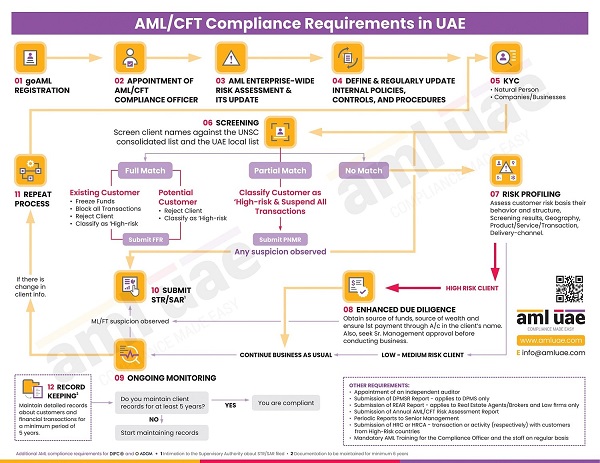
Essential inclusions in AML policies, procedures, and controls
You must follow UAE’s laws and FATF’s recommendations while writing your AML policies, procedures, and controls. This is how you can align with the global AML compliance best practices. The following are the inclusions you must have:
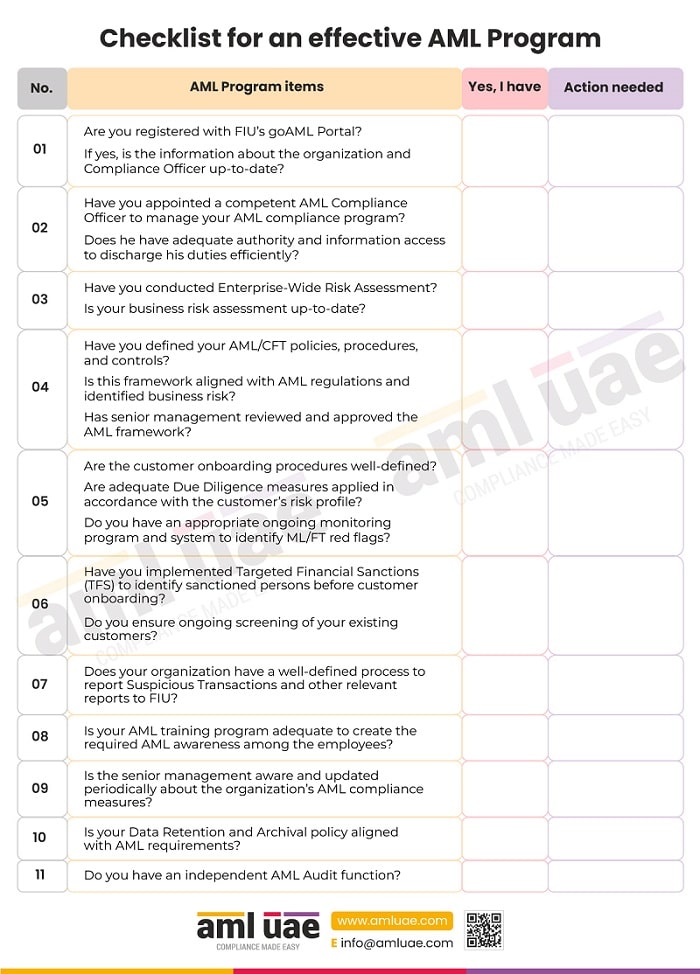
Mandatory regulations to follow
The first thing that needs your attention is the legislation you must follow. You must mention the UAE AML regulations and rules you must follow to achieve compliance.
Ensure that they are up-to-date and accurate for your industry vertical. Also, mention the same for all jurisdictions you operate your business from.
Moreover, you must include the primary provisions to be adhered to over the period – like your annual, semi-annual, quarterly, or monthly compliance requirements. It allows you to track your compliance status with the regulatory obligations.
Goals, objectives, and commitment to AML
Your AML policy must include the significant goals you aim to achieve. These can include achieving AML compliance and improving your business reputation, among others. Mentioning this helps you and your team stay aligned and focused. You can keep striving to achieve those goals.
Prove with words your commitment to this AML policy. Many companies create an AML policy. But not everyone can commit to following it. You must show the steps to follow it and achieve the objectives. Thus, you confirm your intent to detect money laundering risks and take corrective actions.
Risk assessment procedures and system
You must include the risk identification, assessment, and management procedures. This includes listing the potential risks emitting factors like customers, products/services you offer, the geographies to associate with, delivery channels used, etc.
Explain the procedure for identifying the risks under different scenarios. Enumerate the methods you’ll use to assess each risk and assign an appropriate score. Also, describe the possible measures to manage or mitigate these risks.
KYC and CDD measures – list and process
KYC (Know Your Customer) and CDD (Customer Due Diligence) are vital measures for protecting your firm from money laundering threats. It is a way to identify and verify your customers before engaging in business relationships. You must not onboard customers who do not fulfil these requirements.
So, for this, you must mention your business’s KYC and CDD program. You must include information on the following:
- What are the documents you need from customers?
- What are the criteria for customer acceptance?
- When will you perform the necessary checks?
- What is your process of due diligence?
- How will you verify the information from existing and potential customers?
- How the Customer Risk Assessment would be conducted?
- What information and risk criteria would be considered for assessing customer risks?
- When will you conduct Enhanced Due Diligence (EDD)?
- What measures would be applied as part of the EDD process?
- How onboarding of Politically Exposed Persons (PEP) would be handled?
All these information points are essential in KYC and CDD measures. You must answer these questions in the AML policy to clarify their execution.
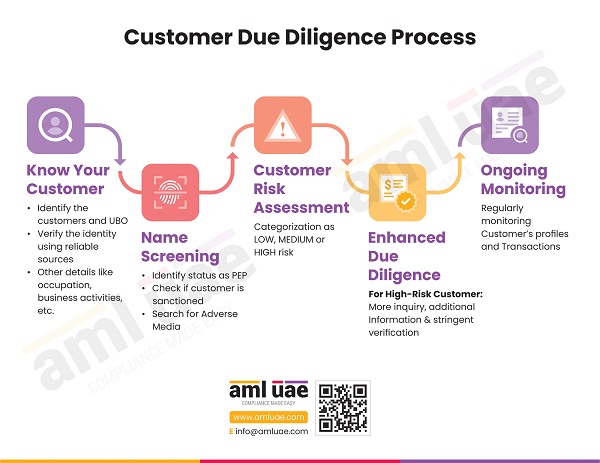
Transaction monitoring process and technology
One factor that enhances your AML compliance is the constant monitoring of transactions. You need it to identify suspicious transactions and prevent their occurrence to reduce your risks.
It would be best if you defined the red flags in your industry to detect suspicious transactions. You must also mention the technology systems or software used for transaction monitoring. Also, define the monitoring rules and threshold for monitoring transactions and its review.
The AML policy must list the actions to take – alerting, reporting, and managing – upon identifying a suspicious transaction. It must also mention the time duration for each action as a rule. In a way, it must clarify the Dos and Don’ts for the team handling transaction monitoring.
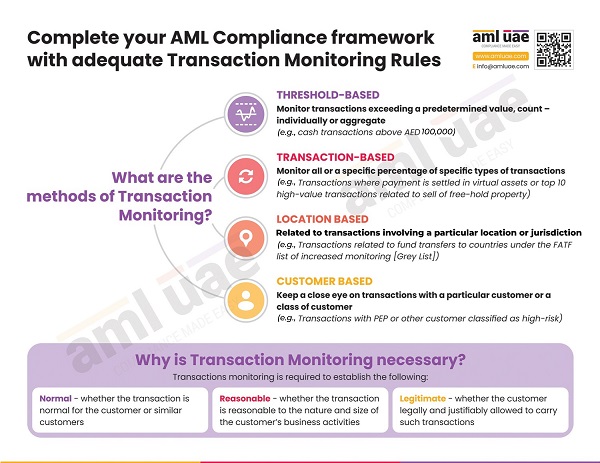
Reporting requirements under the law
Submitting reports to the FIU is a significant part of your AML compliance in the UAE. According to the AML regulations, you are required to submit the following reports:
- Suspicious Activity Report (SAR)
- Suspicious Transaction Report (STR)
- Funds Freeze Report (FFR)
- Partial Name Match Report (PNMR)
- Any other sector-specific report like Dealers in Precious Metals and Stones (DMPSR) and Real Estate Activity Report (REAR)
- High-Risk Country Transaction Report (HRC)
- High-Risk Country Activity Report (HRCA)
You must list these reports, the relevant formats for each, and whom to report to. You must also mention the deadlines for each to avoid missing them. Specifying the person responsible, expected information to be captured, and the procedure for making reports is also crucial.
Record keeping
The AML policy, procedures, and internal controls must include your record-keeping procedures. It must have:
- List of the records you must maintain
- Copies of documents submitted to FIU
- Format and templates
- Mandatory information and data
- Duration for maintaining each record
- Person/team responsible
All this information is essential to ensuring the teams’ diligence in performing their duties. You might use them anytime in the future to revise AML plans or monitor the business relationship. Also, you can submit them to FIU or any other AML Supervisory Authority to provide necessary information when needed.

Internal communication and reporting workflow
Communication workflow is an essential part of the AML policy but is often ignored. Companies forget to define this segment. But, it is crucial to enable smooth and on-time occurrence of AML activities and tasks.
So, you must define the following:
- The reporting structure, specifically for the AML compliance team
- The reports and actions that need approvals and from whom
- The cycles of feedback and reviews a report will go through
- Communication between AML compliance and customer-facing teams
- Communication mediums used within the business
A clear definition of these aspects will help streamline the operations.
Details on the Compliance officer and dedicated team
One of your AML policy’s crucial points is the AML compliance team and the AML Compliance Officer. You must mention this in the policy. It must include information on the following:
- Name of the Compliance Officer (CO)
- Rights of the CO and the team
- Responsibilities and duties of each team member and CO
- The reporting structure of the team
A clear definition of these points makes it easier for the responsible persons to do their duties. Also, the top management is aware of what is happening in AML compliance in the company. It ensures the company as a whole that practical actions are being undertaken for AML compliance.
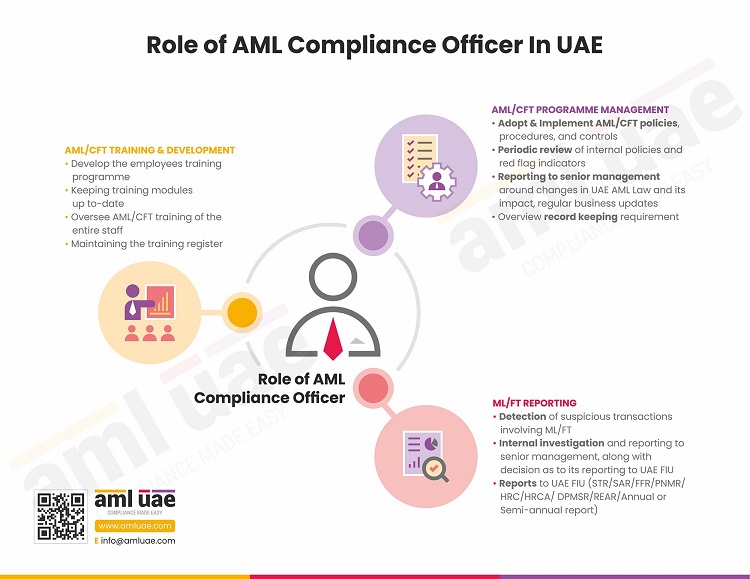
A list of the performance metrics
A plan without key performance indicators is incomplete. Since it mentions what you aim to achieve, you must have the metrics to measure its achievement. So, include the performance metrics for your AML policy, procedures, and controls.
It can be something along the lines of:
- On-time submission of relevant reports
- Accurate identification of suspicious transactions
- Adequate completion of risk profiling of customers
- Proper creation and maintenance of all records
Training needs of employees and execution plan
A crucial requirement for AML compliance is your employees’ alignment with it. AML can be a new concept for your employees, so their knowledge is vital. Also, AML compliance procedures will change internal operations, so employees must accept the changes.
Your AML policy must include information on all these points. You must list the following:
- Different types of AML training programs
- Methods of conducting them
- Possible syllabus for each program
- Duration and frequency of conducting such programs
- Change management plans in the business
By mentioning these points, every new and existing employee is aware of the expectations from them. They will know what employee training programs they have to undertake. Also, you get an idea of the relevant execution plan and budget for such programs.
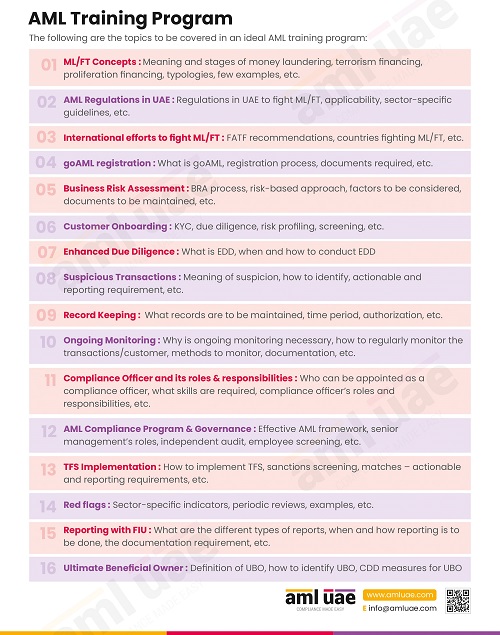
Audit and review strategy for AML policy
Another crucial ingredient of the AML policy is the audit and review strategy. It evaluates your existing AML policies, procedures, and internal controls.
You must have an audit strategy to determine your policy’s accuracy, quality, and completeness. It helps you to know whether the AML policy is sufficient to comply with the AML laws in UAE. This audit and review strategy assesses the following:
- Risk assessment procedures
- Transaction monitoring systems
- KYC and CDD measures you have implemented
- Training programs for your employees
- Effectiveness and accuracy of reports generated and filed with FIU
Thus, you can know how efficiently your AML policy responds to money laundering threats.
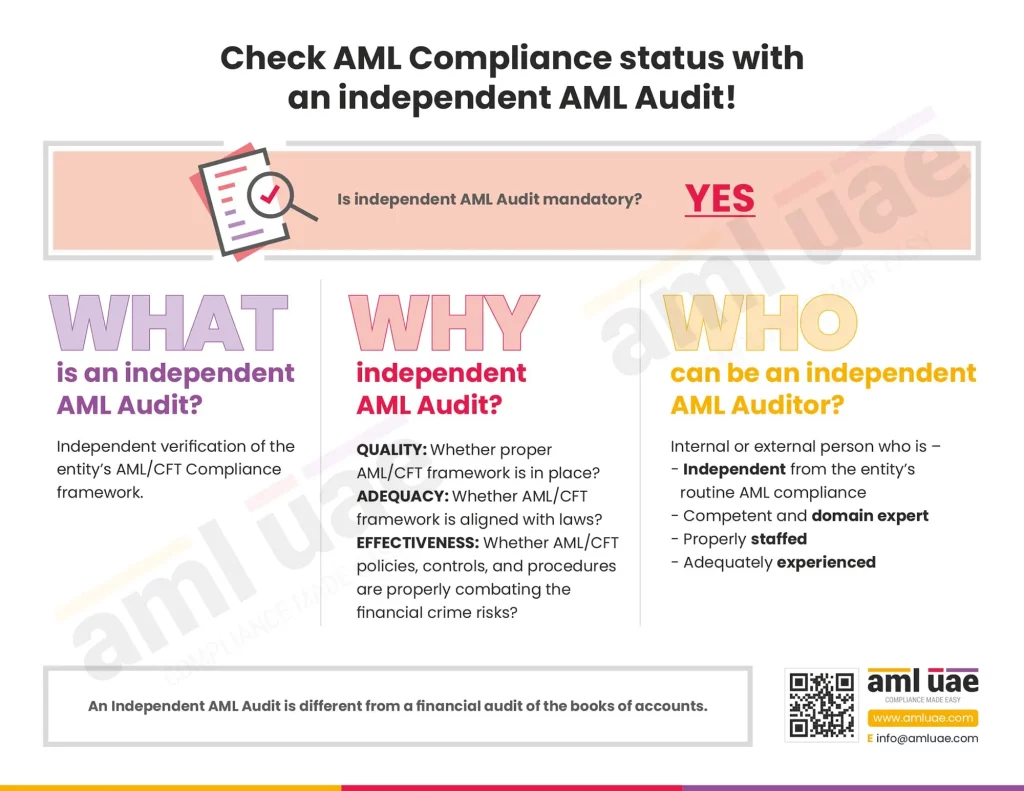
Exclusions in AML policies, procedures, and controls
Impractical expectations
You have your AML goals and objectives to achieve. The AML regulations are in place in the UAE. You know you have to follow them. But that does not mean you will set unrealistic prospects for your business. So, be careful while setting processes, procedures, measures, controls, responsibilities, and commitments.
Duplicate information
Ensure there is no duplicate information while writing AML policies, procedures, and controls. Already, it is a detailed document. If you repeat the same thing, your employees may lose interest. Specifically, don’t mention the detailed laws and regulations in your policy statements. Use them as a reference to explain your point.

Ambiguous and complicated words
Using big, complicated words or jargon won’t help. Your employees will get confused. Ambiguous language might lead to errors, as your stakeholders might misinterpret it.
It’s better to keep it short and straightforward. Using clear language makes it easy for your employees to understand what the AML policy says.
Outdated data and information
Keeping yourself up-to-date with changes is the path to success. It is also the way you can enhance your AML compliance. So, review your policy frequently. Make changes and update it as and when needed to stay aligned with emerging risk typologies and recent regulatory amendments. Keeping outdated information will lead to gaps in your AML compliance.
Negative language
Using too many negative statements will demotivate your employees. Use more positive words. So, talk less about the penalties or legal actions in case of non-compliance. Focus more on how compliance with AML laws benefits you, your country, and the world. This is how you motivate your employees for ethical behaviour and AML compliance.
Your one-stop destination for AML compliance – AML UAE
So, now you know the significant inclusions and exclusions of your AML policy. Include these in your policies, procedures, and controls for effective AML compliance.
If you are unsure of your AML policy, let us do it for you.
AML UAE is a reliable AML compliance services provider to businesses operating in the UAE. We help you follow the relevant AML procedures on time. We also help you create a firm AML policy and control system to prevent the effects of money laundering threats. Our services strengthen your fight against the dynamic financial crime scenario. So, if you need any kind of support for complying with AML laws, you can trust us.
Make significant progress in your fight against financial crimes,
With the best consulting support from AML UAE.
Our recent blogs
side bar form
Share via :
About the Author
Jyoti Maheshwari
CAMS, ACA
Jyoti has over 6 years of hands-on experience in regulatory compliance, policymaking, risk management, technology consultancy, and implementation. She holds vast experience with Anti-Money Laundering rules and regulations and helps companies deploy adequate mitigation measures and comply with legal requirements. Jyoti has been instrumental in optimizing business processes, documenting business requirements, preparing FRD, BRD, and SRS, and implementing IT solutions.
